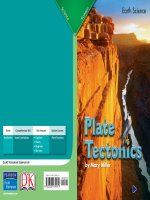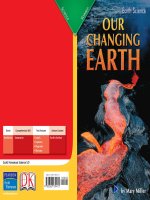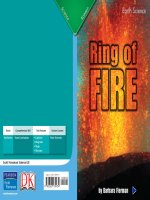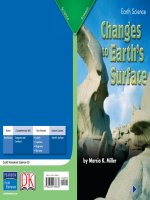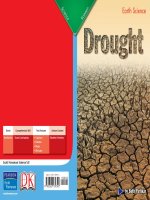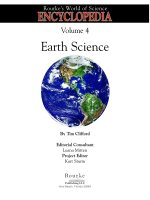earth science drought
Bạn đang xem bản rút gọn của tài liệu. Xem và tải ngay bản đầy đủ của tài liệu tại đây (5.29 MB, 14 trang )
Scott Foresman Science 5.8
Genre Comprehension Skill Text Features Science Content
Nonfi ction Draw Conclusions • Captions
• Sidebar
• Maps
• Glossary
Weather Patterns
ISBN 0-328-13939-4
ì<(sk$m)=bdjdjc< +^-Ä-U-Ä-U
13939_01-04_CVR_FSD.indd Cover113939_01-04_CVR_FSD.indd Cover1 5/10/05 2:15:13 PM5/10/05 2:15:13 PM
Scott Foresman Science 5.8
Genre Comprehension Skill Text Features Science Content
Nonfi ction Draw Conclusions • Captions
• Sidebar
• Maps
• Glossary
Weather Patterns
ISBN 0-328-13939-4
ì<(sk$m)=bdjdjc< +^-Ä-U-Ä-U
13939_01-04_CVR_FSD.indd Cover113939_01-04_CVR_FSD.indd Cover1 5/10/05 2:15:13 PM5/10/05 2:15:13 PM
1. How can a region’s climate make it more
likely to suffer from droughts?
2. If seasonal rains are important for crops to
grow in a certain country and those rains
don’t happen for two years in a row, what
may happen to the people of that country?
3. Why do some scientists think that droughts
will happen more often in the future?
4.
El Niño brings rain to
normally dry regions, causes drought in
others, and causes extreme weather around
the world. Write to explain some of the
effects of El Niño. Use examples from the
book to support your answers.
5.
Draw Conclusions Why should
water be conserved when a drought
has already started?
What did you learn?
Extended Vocabulary
cover crops
deforestation
desertifi cation
economic
famine
malnutrition
overpopulation
resources
terracing
topsoil
Vocabulary
air mass
anemometer
barometer
climate
convection current
front
rain gauge
Picture Credits
Every effort has been made to secure permission and provide appropriate credit for photographic material.
The publisher deeply regrets any omission and pledges to correct errors called to its attention in subsequent editions.
Photo locators denoted as follows: Top (T), Center (C), Bottom (B), Left (L), Right (R), Background (Bkgd).
Opener: A. Ishokon/UNEP/Peter Arnold, Inc.; 1 Anthony Bannister/NHPA Limited; 3 Digital Vision;
4–5 Anthony Bannister/NHPA Limited; 5 (TR) Adrian Arbib/Corbis; 6–7 Dieter Telemans/Panos Pictures;
8 (BL) Yann Arthus-Bertrand/Corbis; 9 A. Ishokon/UNEP/Panos Pictures; 10–11 (B) Ferdinando Scianna/©Magnum
Photos; 11 (C) Herbie Knott/Rex Features, Ltd; 12–13 (B) John Maier Jr./Argus Fotoarchiv/Corbis; 14 (B) Reuters/Corbis;
15 Liba Taylor/Hutchison Picture Library; 16–17 Chris Stowers/Panos Pictures; 18–19 (B) Corbis;
20 Ron Giling/Peter Arnold, Inc.; 21 Mark Edwards/Peter Arnold, Inc.; 22–23 Yann Arthus-Bertrand/Corbis.
Unless otherwise acknowledged, all photographs are the copyright © of Dorling Kindersley, a division of Pearson.
ISBN: 0-328-13939-4
Copyright © Pearson Education, Inc. All Rights Reserved. Printed in the United States of America.
This publication is protected by Copyright, and permission should be obtained from the publisher prior to any
prohibited reproduction, storage in a retrieval system, or transmission in any form by any means, electronic,
mechanical, photocopying, recording, or likewise. For information regarding permission(s), write to
Permissions Department, Scott Foresman, 1900 East Lake Avenue, Glenview, Illinois 60025.
3 4 5 6 7 8 9 10 V010 13 12 11 10 09 08 07 06 05
13939_01-04_CVR_FSD.indd Cover213939_01-04_CVR_FSD.indd Cover2 5/10/05 2:15:22 PM5/10/05 2:15:22 PM
by Beth Parlikar
13939_05-28_FSD.indd 113939_05-28_FSD.indd 1 5/10/05 2:15:51 PM5/10/05 2:15:51 PM
Weather is made up of the conditions of the atmosphere
at a given moment, and it can change very quickly.
Measurements of temperature, air pressure, wind speed and
direction, and precipitation are used to describe the weather.
The atmosphere is made up of air, which is a mixture
of gases such as nitrogen and oxygen. The atmosphere has
fi ve layers. Air temperature changes as you go up through
the layers.
Cool air is heavier than warm air because the gas
particles in cool air are closer together. The differences
in air temperature cause air to move, and air movement
creates currents, which affect weather. When cool air and
warm air come together, the cool air sinks and the warm air
rises. This looping movement of air is called a convection
current. These currents can create clouds, rain, and other
weather patterns.
What You Already Know
2
When warm air
and cool air meet,
rain can occur.
13939_05-28_FSD.indd 213939_05-28_FSD.indd 2 5/10/05 2:15:57 PM5/10/05 2:15:57 PM
An air mass is a huge
body of air that has similar
conditions throughout.
Air masses move because
of winds and can be warm
or cold, wet or dry. Fronts
are boundaries between
air masses. Precipitation
often happens when a front
moves through an area.
Meteorologists use
patterns of weather changes
from the past to predict
future weather. They use
many instruments to
measure weather conditions. A barometer measures air
pressure, an anemometer is used to determine wind speed,
and a rain gauge measures how much rain has fallen.
Climate is not the same as weather. Climate is the
average of weather conditions for an area over a number
of years.
In this book you will read about a weather condition
called drought. You will learn how droughts affect
environments and people.
area affected by drought, Botswana
3
13939_05-28_FSD.indd 313939_05-28_FSD.indd 3 6/16/05 2:53:54 PM6/16/05 2:53:54 PM
What is drought? If you think it’s a period of time with
little or no rainfall, you’re partly right. Droughts are long
periods of reduced precipitation that usually last for months
or even years. Drought is actually a normal part of climate and
can occur anywhere on Earth, from deserts to rain forests.
Depending upon its location, length, and severity, drought
can have many different effects on people and the environment.
Agriculture is often affected during a drought; crops might
fail, and farm animals might die. People have less food
to eat, and they might suffer from hunger,
malnutrition, or starvation.
Introduction
Drought can cause
crops to fail.
4
13939_05-28_FSD.indd 413939_05-28_FSD.indd 4 5/10/05 2:16:00 PM5/10/05 2:16:00 PM
Drought can have many other
effects. Dry conditions can cause
wildfi res and dust storms, and wild
animals can die from lack of food and
water as natural vegetation decreases.
Water supplies are lower than usual
during a drought, so people might be
asked to conserve water. If a drought
lasts a long time and is severe, people
may even abandon their homes and
move to an area with more water.
Aid organizations provide
food for drought sufferers.
5
13939_05-28_FSD.indd 513939_05-28_FSD.indd 5 5/10/05 2:16:06 PM5/10/05 2:16:06 PM
Why do droughts happen? Scientists have found that
droughts are usually a result of many factors. Climate is
one thing that determines when and where droughts occur.
Some parts of the world are more prone to droughts
because the weather varies a lot from year to year. Some
regions get seasonal rains that are important for animals’
survival and for crops to grow. If those rains don’t come,
the drought can kill animals and crops, and people may
even die. Climate change can cause droughts to happen
more often and turn fertile land into desert.
Global weather patterns can also help to cause droughts.
Certain weather patterns happen periodically and can lead
to drought in different parts of the world.
6
13939_05-28_FSD.indd 613939_05-28_FSD.indd 6 5/10/05 2:16:09 PM5/10/05 2:16:09 PM
One such weather pattern that happens every few years is
called El Niño. This pattern is caused by a shift in the winds
and ocean currents off the coast of South America. The
effects of this event can spread across the world, bringing
droughts to normally wet regions and fl oods to dry ones.
People can cause droughts to be more likely to happen.
For example, poor farming practices, such as overgrazing
and clear-cutting of trees for fi rewood, can cause the land
to lose moisture easily. This can make a drought far worse
than usual. If many people move to an area that is prone to
droughts, they may have problems. The more people there
are, the more water they need to survive. If the rains don’t
come, those people may run out of water quickly.
Survival in a dry region
can be very diffi cult.
7
13939_05-28_FSD.indd 713939_05-28_FSD.indd 7 5/10/05 2:16:15 PM5/10/05 2:16:15 PM
An area’s average weather conditions are called its
climate. However, the weather at any one time can be very
different from the average. For example, the summer in
California is usually hot and dry, but sometimes there are big
storms that bring rain. Changes from normal conditions can
lead to droughts if precipitation is less than normal. These
droughts can be devastating if a region needs seasonal rains
for crops to grow.
Climates don’t always stay the same over time. In fact,
they can change drastically and sometimes quickly. For
example, sudden volcanic eruptions can block sunlight and
change the climate over a large area. Other times, climate
changes slowly. Sometimes the cause of slow climate change
is natural. One natural cause of climate change is variation in
the strength of the Sun’s energy, which warms the Earth.
People also cause climate change. Most scientists believe
that a process called global warming is happening because
cars and factories make gases that warm up the atmosphere.
Global warming is changing the patterns of the water cycle.
Scientists think that land in the middle of continents will
have more droughts, and deserts will grow bigger.
Climate
As an area becomes drier, some
rivers may dry up entirely, as this
former river in Argentina has.
8
13939_05-28_FSD.indd 813939_05-28_FSD.indd 8 5/10/05 2:16:17 PM5/10/05 2:16:17 PM
9
Water is very scarce in
some parts of India.
13939_05-28_FSD.indd 913939_05-28_FSD.indd 9 5/10/05 2:16:18 PM5/10/05 2:16:18 PM
Ethiopia is a country in
East Africa with a population
of sixty-seven million people.
Of these, 90 percent are
subsistence farmers, meaning
that they make a living by
growing just enough food to eat.
The soil is good, but there isn’t
much rainfall most of the year.
The rains usually come between
June and September and are very
important for farming and for
the people’s survival.
Case Study: Ethiopia 1981–1985
Most of Ethiopia, a country
in East Africa, suffered from
drought for several years
in a row.
Ethiopia
Area worst
affected by
drought
AFRICA
Ethiopia
10
13939_05-28_FSD.indd 1013939_05-28_FSD.indd 10 5/10/05 2:16:25 PM5/10/05 2:16:25 PM
Beginning in 1981, the seasonal rains that are so
important for survival in Ethiopia did not come. In most
parts of the country, all or almost all of the crops died, and
people did not get enough to eat. This continued through
the years of 1982, 1983, and 1984, until the drought was so
severe that eight million people were in danger of starving
to death.
Finally the people of the world came to help, bringing
food, medicines, and clothing. But it was already too late
for many: almost one million people starved to death.
Thousands of others left Ethiopia and went to nearby
countries in search of food and shelter.
Since the terrible famine of 1981–1985, Ethiopia has
suffered from two more major droughts. Today the country
is trying to conserve water more carefully and educate its
people about health, nutrition, and good farming practices.
Millions of dollars were spent on food and medical aid
for Ethiopians during the drought of 1981–1985.
11
13939_05-28_FSD.indd 1113939_05-28_FSD.indd 11 5/10/05 2:16:32 PM5/10/05 2:16:32 PM
El Niño means “the child,” and it gained its name
because it arises around Christmas. It is a weather pattern
that causes disruptive events every few years. El Niño starts
out in the southern Pacifi c Ocean, where the winds usually
blow from east to west. Warm water normally collects along
the eastern coast of Australia. Meanwhile, currents of cold
water fl ow along the western coast of South America.
During El Niño, the warm water current suddenly rushes
across the ocean from west to east. The warm, moist air that
usually brings the monsoon rains to Southeast Asia is no
longer there, so the monsoons don’t come on time. Across
the ocean, the desert along the coast of Peru receives heavy
rains. The effects don’t stop there, though. El Niño can affect
weather patterns from Florida to Africa!
Scientists aren’t sure what makes El Niño happen,
but they do know something about its effects. The sudden
presence of warm, moist air over South America causes
convection currents in the atmosphere to shift. These huge
currents affect weather throughout the world.
El Niño
El Niño often causes drought
in the Amazon River region in
Brazil, increasing the risk of
forest fi res.
12
13939_05-28_FSD.indd 1213939_05-28_FSD.indd 12 5/10/05 2:16:36 PM5/10/05 2:16:36 PM
El Niño
Under normal conditions
in the South Pacifi c, warm
water collects in the west,
and cold water in the east.
This makes the air warm
and moist in Southeast
Asia, while coastal Peru is
a desert.
During El Niño, a mass of
warm water moves across
the ocean from Australia
and along the equator
to the coast of South
America. This brings rain to
normally dry Peru and can
affect the weather around
the world.
Mexico
Mexico
Equator
NORTH
AMERICA
SOUTH
AMERICA
CENTRAL
AMERICA
Pacifi c
Ocean
SOUTHEAST
ASIA
Australia
cold currents
NORTH
AMERICA
SOUTH
AMERICA
CENTRAL
AMERICA
Pacifi c
Ocean
SOUTHEAST
ASIA
Australia
warm currents
13
N
E
S
W
N
E
S
W
13939_05-28_FSD.indd 1313939_05-28_FSD.indd 13 5/10/05 2:16:43 PM5/10/05 2:16:43 PM
The strongest El Niño of
the past century struck in 1997.
It brought extreme weather that
devastated the countries of Central
America. Droughts occurred
throughout the region, causing
many crops to fail. Unusual
rains caused fl oods that also hurt
food production and endangered
people’s lives.
There were outbreaks of
tropical diseases, which made
thousands of people very sick.
The worst forest fi res on record
destroyed rain forests and
polluted the air as far away as
the eastern United States. Water
levels in rivers and lakes fell so
low that the country of Honduras
declared a state of emergency.
Case Study: Central America 1997–1998
El Niño caused drought,
fl ooding, and forest fi res,
which overwhelmed
Central American
countries in 1997–1998.
NORTH AMERICA
SOUTH AMERICA
CENTRAL AMERICA
Many farmers in Central America
lost their crops due to drought
caused by El Niño.
Gulf of Mexico
Pacifi c Ocean
14
13939_05-28_FSD.indd 1413939_05-28_FSD.indd 14 5/10/05 2:16:48 PM5/10/05 2:16:48 PM
Wildlife suffered from
the severe weather as well.
Fewer sea turtles hatched on
beaches in Central America
and Mexico because of high
tides and drought. Many
coral reefs, which are made up
of tiny animals called coral
polyps, died or were damaged
because the water grew too
hot. Fishermen also reported
that there were very few fi sh
to be found in the oceans.
As the terrible effects of El Niño continued,
thousands of people found themselves without enough
food to eat. Aid organizations from around the world
stepped in to help, bringing food and other supplies
for the people. Unfortunately, relief for the people of
Central America did not last long, as Hurricane Mitch
devastated the region in 1998.
Another drought struck in 2001, and this time
three-quarters of a million people were in need of food
aid. The people of Central America suffered a great
deal from these natural disasters. When terrible events
like these happen, it is important for people to work
together to help everyone recover.
International aid workers gave food
to thousands of hungry people.
15
13939_05-28_FSD.indd 1513939_05-28_FSD.indd 15 5/10/05 2:16:56 PM5/10/05 2:16:56 PM
People’s actions can affect how bad droughts are and
how often they happen. For instance, if too many people
decide to live in a region that is prone to droughts, they can
put a strain on land and water resources. People need water
for cooking, washing, and growing food. The more people
that live in an area, the more water they need. The increasing
number of people in the world is also a problem. The more
people there are on Earth, the more water is required to
meet their needs. Overpopulation is therefore one factor
that can worsen droughts.
Poor farming practices can also increase the risk of
drought. In some areas farmers clear land so that they can
grow more crops, even if the land is not good for farming.
In order to clear land, they burn or cut down forests. This
makes the soil dry up easily and blow away or be washed
away by storms. This soil erosion makes it very hard to
grow crops.
Overpopulation and
Poor Farming Practices
The soil in deforested areas
often becomes hard and dry,
making it drought-prone and
diffi cult to farm.
16
13939_05-28_FSD.indd 1613939_05-28_FSD.indd 16 5/10/05 2:16:58 PM5/10/05 2:16:58 PM
Deforestation is also bad for drought prevention because
trees help to control global warming by capturing some of
the gases that cars and factories release.
Animal grazing can also make the land dry. If animals
such as cows and goats are allowed to eat too much of the
grass in an area, this can have the same effect as burning
down forests. Soil erosion and overgrazing can cause areas
that used to have plant life to become deserts. This process
is called desertifi cation.
17
13939_05-28_FSD.indd 1713939_05-28_FSD.indd 17 5/10/05 2:17:04 PM5/10/05 2:17:04 PM
During the 1930s the
United States suffered from
a severe and long-lasting drought
that in its worst year affected
70 percent of the country. The
drought was centered in the
Great Plains, including Kansas,
Oklahoma, and northern Texas.
Over the years, cattle grazing
and poor farming practices had
caused the topsoil to erode, or
be swept away. Therefore, when
a drought came and the soil
became dry, winds created great clouds of dust. Sometimes
these dust storms blocked out the sunlight for days. For this
reason, this disaster is known as the American Dust Bowl.
Case Study: American Dust Bowl, 1930s
Huge dust storms devastated
the Great Plains states during
the great Dust Bowl of the 1930s.
Area affected
by dust storms
Dodge City
U.S.
Dodge
City
Area of greatest
soil erosion
Many farms such as this one were
enveloped by dust storms during
the Dust Bowl drought.
18
13939_05-28_FSD.indd 1813939_05-28_FSD.indd 18 5/10/05 2:17:07 PM5/10/05 2:17:07 PM
The social and economic effects of the Dust Bowl
drought were enormous. Thousands of farmers ran
out of money and had to sell or abandon their farms.
One-quarter of the area’s population left; many
people made their way west to California. When they
got there, many had trouble fi nding work. During the
decade, a total of 2.5 million people migrated out of
the Plains states.
The lessons that were learned from the Dust Bowl
have helped to change farming practices in the United
States. Soil erosion had become such a problem that
in 1935 the government created a special program
to help control it. Farmers were paid to prevent soil
erosion by using farming practices that anchor the
soil. Some of these practices included terracing and
the use of cover crops. These techniques are still used
today to prevent soil erosion.
19
13939_05-28_FSD.indd 1913939_05-28_FSD.indd 19 5/10/05 2:17:14 PM5/10/05 2:17:14 PM
There are many aid agencies that help people in areas
suffering from drought. Some agencies provide money and
other resources to farmers whose crops suffer because of
drought. Other agencies, such as the Red Cross, give food
and water to people in drought-stricken areas who are sick
and malnourished.
There are many things people can do to lessen the effects
of a drought. If the drought has already started, one of the
most important things is to conserve water. Nonessential uses
of water, such as for recreation, watering lawns, and washing
cars, should be reduced during a drought. Cities and towns
may actually require their residents to stop or limit these
activities. People can also install devices in their homes that
reduce the amount of water used by sinks, toilets, showers,
and sprinklers.
Even before a drought starts, there are many things
people can do to help prevent problems. Planting native
plants and trees helps to hold moisture inside the soil and
anchor it. Using smart farming and ranching techniques is
also important. Finally, people can help others learn why
conserving water is important and what they can do to help.
Prevention and Aid
Planting trees can help
to prevent soil erosion
and drought.
20
13939_05-28_FSD.indd 2013939_05-28_FSD.indd 20 5/10/05 2:17:16 PM5/10/05 2:17:16 PM
Clean water is a scarce
resource in many parts
of the world.
21
13939_05-28_FSD.indd 2113939_05-28_FSD.indd 21 5/10/05 2:17:16 PM5/10/05 2:17:16 PM
Drought occurs when a region receives less rain or snow
than usual. Drought can be very bad for people and the
environment. Crops can fail and animals can die, leading to
food shortages. If the drought lasts very long, people may
become malnourished and even die of starvation. People
may also decide to leave the area suffering from drought,
abandoning farms or entire towns. Wildfi res may burn the
dry plants and trees, polluting the air and killing wild animals.
Droughts usually have more than one cause. One factor
is climate. If the weather tends to vary quite a bit, with some
years being much drier than others, then droughts are more
likely to happen.
Summary
22
13939_05-28_FSD.indd 2213939_05-28_FSD.indd 22 5/10/05 2:17:20 PM5/10/05 2:17:20 PM
Most scientists believe that global warming is changing
climates all over the world. They think that this may make
droughts happen more often in the future.
El Niño is a weather pattern that occurs every few years
in the southern Pacifi c Ocean. El Niño’s effects on weather
can spread to much of the world. During this time we
can expect more droughts, as well as storms and extreme
temperatures. El Niño caused droughts in Central America
in the 1990s.
Human actions can also contribute to droughts.
The world’s growing population puts a strain on water
resources. Some types of farming practices also make the
land prone to drought. Activities such as teaching people
about water conservation and planting trees are ways you
can help prevent droughts.
23
13939_05-28_FSD.indd 2313939_05-28_FSD.indd 23 5/10/05 2:17:26 PM5/10/05 2:17:26 PM
Glossary
cover crops crops planted to prevent soil erosion
deforestation removal of all the trees from an area
of land
desertifi cation a process by which land becomes drier
and drier until plants no longer grow well
on it and it becomes a desert
economic relating to material goods and resources
famine a severe shortage of food resulting
in hunger and starvation
malnutrition a lack of some important nutrients
in the diet
overpopulation a state in which the amount of some
resources is inadequate because too many
individuals are living in an area
resources things that are useful or necessary
terracing a farming technique in which level strips
of land on a hillside are planted with
crops
topsoil the top layer of soil, which is usually good
for growing plants
24
13939_05-28_FSD.indd 2413939_05-28_FSD.indd 24 5/10/05 2:17:28 PM5/10/05 2:17:28 PM
1. How can a region’s climate make it more
likely to suffer from droughts?
2. If seasonal rains are important for crops to
grow in a certain country and those rains
don’t happen for two years in a row, what
may happen to the people of that country?
3. Why do some scientists think that droughts
will happen more often in the future?
4.
El Niño brings rain to
normally dry regions, causes drought in
others, and causes extreme weather around
the world. Write to explain some of the
effects of El Niño. Use examples from the
book to support your answers.
5.
Draw Conclusions Why should
water be conserved when a drought
has already started?
What did you learn?
Extended Vocabulary
cover crops
deforestation
desertifi cation
economic
famine
malnutrition
overpopulation
resources
terracing
topsoil
Vocabulary
air mass
anemometer
barometer
climate
convection current
front
rain gauge
Picture Credits
Every effort has been made to secure permission and provide appropriate credit for photographic material.
The publisher deeply regrets any omission and pledges to correct errors called to its attention in subsequent editions.
Photo locators denoted as follows: Top (T), Center (C), Bottom (B), Left (L), Right (R), Background (Bkgd).
Opener: A. Ishokon/UNEP/Peter Arnold, Inc.; 1 Anthony Bannister/NHPA Limited; 3 Digital Vision;
4–5 Anthony Bannister/NHPA Limited; 5 (TR) Adrian Arbib/Corbis; 6–7 Dieter Telemans/Panos Pictures;
8 (BL) Yann Arthus-Bertrand/Corbis; 9 A. Ishokon/UNEP/Panos Pictures; 10–11 (B) Ferdinando Scianna/©Magnum
Photos; 11 (C) Herbie Knott/Rex Features, Ltd; 12–13 (B) John Maier Jr./Argus Fotoarchiv/Corbis; 14 (B) Reuters/Corbis;
15 Liba Taylor/Hutchison Picture Library; 16–17 Chris Stowers/Panos Pictures; 18–19 (B) Corbis;
20 Ron Giling/Peter Arnold, Inc.; 21 Mark Edwards/Peter Arnold, Inc.; 22–23 Yann Arthus-Bertrand/Corbis.
Unless otherwise acknowledged, all photographs are the copyright © of Dorling Kindersley, a division of Pearson.
ISBN: 0-328-13939-4
Copyright © Pearson Education, Inc. All Rights Reserved. Printed in the United States of America.
This publication is protected by Copyright, and permission should be obtained from the publisher prior to any
prohibited reproduction, storage in a retrieval system, or transmission in any form by any means, electronic,
mechanical, photocopying, recording, or likewise. For information regarding permission(s), write to
Permissions Department, Scott Foresman, 1900 East Lake Avenue, Glenview, Illinois 60025.
3 4 5 6 7 8 9 10 V010 13 12 11 10 09 08 07 06 05
13939_01-04_CVR_FSD.indd Cover213939_01-04_CVR_FSD.indd Cover2 5/10/05 2:15:22 PM5/10/05 2:15:22 PM

